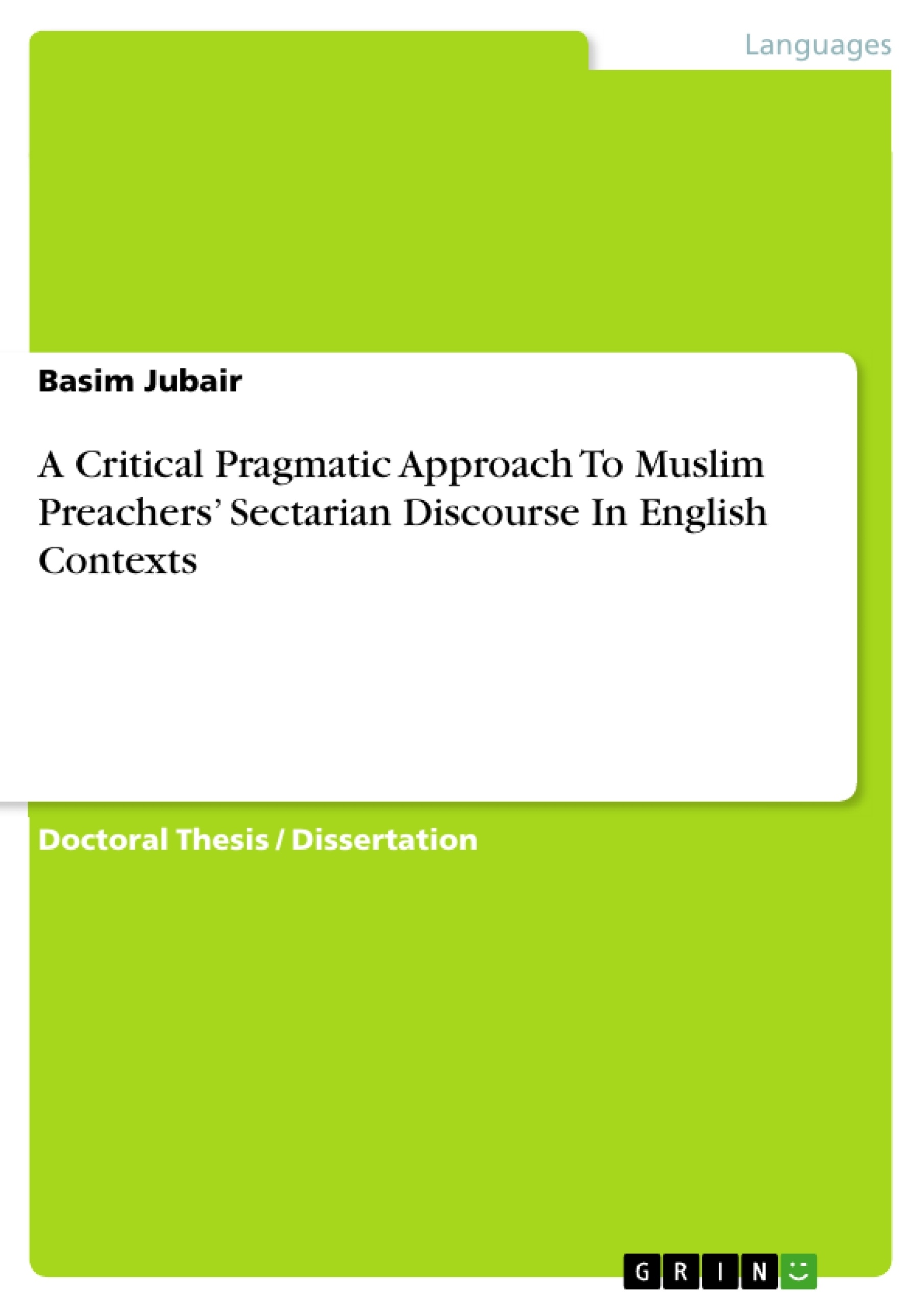This study is concerned with sectarianism as a social and pragmatic act which is critically manifested by the Sunni and Shiite preachers, for which a critical pragmatic approach of analysis is introduced. It addresses how sectarian discourse, which is issued by the British and American Muslim preachers, is pragmatically conveyed and how to reproduce such sectarian discourse in order to de-sectarianize it.
Certain relevant questions are raised. These questions are related to the defining criteria, ideological forms and strategies of the sectarian discourse, the pragmatic strategies, the critical pragmatic mechanisms, socio-cultural aspects used by Muslim preachers in British and American different communities to indoctrinate sectarianism, and others.
The study attempts to develop a model to investigate its aims, which are concerned with providing the most frequent linguistic criteria, discovering the ideological forms and strategies, pinpointing the most outstanding pragmatic strategies, discovering the socio-cultural dimensions and variables, identifying the pragmatic functions of sectarianism and finding out the similarities and differences between the British and American contexts.
These aims can be reached out through certain procedures which can be briefed as follows: reviewing the literature about criticality in pragmatics, setting operational definitions, presenting an account about the concept of sectarianism among Muslim communities, and a workable model is developed to analyze the data which are selected randomly from both of the British and the American contexts. This study introduces practical conclusions. Muslim preachers adopt ideological strategies to convey sectarianism; pragmatics plays a key role in interpreting the act of sectarian discourse critically; the preachers use socio-cultural factors as represented by the principles of politeness and impoliteness to indoctrinate and sectarianize the audience; and the British and American preachers use different identifying criteria and contextual factors.
Inhaltsverzeichnis (Table of Contents)
- Chapter 1: Introduction
- 1.1: Background of the Study
- 1.2: Statement of the Problem
- 1.3: Aims of the Study
- 1.4: Research Questions
- 1.5: Significance of the Study
- 1.6: Scope and Limitations of the Study
- 1.7: Definition of Key Terms
- Chapter 2: Literature Review
- 2.1: Critical Pragmatics
- 2.2: Sectarianism
- 2.3: Muslim Preachers' Discourse
- 2.4: The British and American Contexts
- Chapter 3: Theoretical Framework
- 3.1: Critical Pragmatic Approach
- 3.2: The Role of Ideology in Sectarian Discourse
- 3.3: Socio-cultural Factors in Sectarian Discourse
- Chapter 4: Methodology
- 4.1: Research Design
- 4.2: Data Collection
- 4.3: Data Analysis
- Chapter 5: Results and Analysis
- 5.1: Identifying Criteria for Sectarian Discourse
- 5.2: Ideological Forms and Strategies
- 5.3: Pragmatic Strategies
- 5.4: Socio-cultural Dimensions and Variables
- Chapter 6: Discussion
- 6.1: The Role of Critical Pragmatics in Analyzing Sectarian Discourse
- 6.2: The Impact of Socio-cultural Factors on Sectarian Discourse
- 6.3: Similarities and Differences between British and American Contexts
Zielsetzung und Themenschwerpunkte (Objectives and Key Themes)
This study investigates the nature of sectarian discourse among Sunni and Shiite Muslim preachers in English-speaking contexts. It aims to understand how sectarianism is pragmatically conveyed and reproduced in the discourse of these preachers, ultimately aiming to de-sectarianize it. The study explores the criteria, ideological forms, and pragmatic strategies employed by these preachers, highlighting the socio-cultural factors that influence their discourse and the pragmatic functions of sectarianism. Key themes addressed include:- The critical pragmatic analysis of sectarian discourse.
- The role of ideology and socio-cultural factors in shaping sectarian discourse.
- The pragmatic strategies employed by Muslim preachers to convey and reproduce sectarianism.
- The impact of context on sectarian discourse in British and American Muslim communities.
- Developing a model to analyze sectarian discourse in English contexts.
Zusammenfassung der Kapitel (Chapter Summaries)
Chapter 1 provides a comprehensive overview of the study, including its background, statement of the problem, aims, research questions, significance, scope, limitations, and definitions of key terms. Chapter 2 presents a comprehensive literature review covering critical pragmatics, sectarianism, Muslim preachers' discourse, and the British and American contexts. Chapter 3 introduces the theoretical framework, focusing on the critical pragmatic approach, the role of ideology in sectarian discourse, and the influence of socio-cultural factors. Chapter 4 details the research methodology, outlining the research design, data collection methods, and data analysis procedures. Chapter 5 presents the results of the study, focusing on identifying criteria for sectarian discourse, analyzing ideological forms and strategies, examining pragmatic strategies, and exploring socio-cultural dimensions and variables. Chapter 6 discusses the findings, examining the role of critical pragmatics in analyzing sectarian discourse, the impact of socio-cultural factors, and highlighting similarities and differences between British and American contexts.Schlüsselwörter (Keywords)
The study primarily focuses on critical pragmatics, sectarian discourse, Muslim preachers, ideological strategies, socio-cultural factors, and the British and American contexts. It also explores the concept of de-sectarianization through pragmatic analysis.- Quote paper
- Basim Jubair (Author), 2021, A Critical Pragmatic Approach To Muslim Preachers’ Sectarian Discourse In English Contexts, Munich, GRIN Verlag, https://www.grin.com/document/1215854



